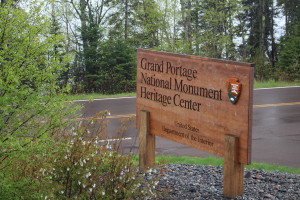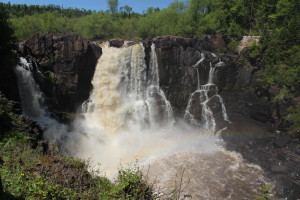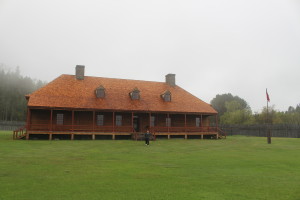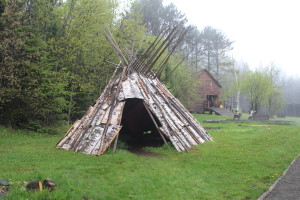 Tom and I will be working at Grand Portage National Monument for the summer. You have probably never heard of Grand Portage National Monument, so this post is an introduction to the monument and its purpose.
Tom and I will be working at Grand Portage National Monument for the summer. You have probably never heard of Grand Portage National Monument, so this post is an introduction to the monument and its purpose.
Grand Portage is the place where east met west in North America. It was the place where fur merchants from Montreal met fur traders from the west. It is also the path used by Native Americans for 500 years before the Europeans arrived. It is the native homeland of the Ojibwe, continuously occupied by them since 1400. It is the place where the Ojibwe and the Europeans entered into a peaceful trade that thrived for almost 150 years.

Grand Portage is a natural depression in the line of mountains along the coast of northern Minnesota. Whether people were traveling from east to west or from west to east, the lakes and rivers would funnel them to the Pigeon River which flowed into Lake Superior. But the Pigeon River has a waterfall that is 120 feet high – the highest in Minnesota. So whoever was traveling on it had to carry their canoes around the falls. Because the falls have steep basalt cliffs on either side, those who were portaging around the falls used the eight mile path through the natural depression to Lake Superior.

At the height of the fur trade in North American, the Northwest Company built a depot at Grand Portage where east met west. Voyageurs, the freight-truck drivers of the 1700’s, would transport furs from outposts in the west to Grand Portage. Other Voyageurs transported trade goods from Montreal to Grand Portage. For a couple of weeks a year, everyone would come together at Grand Portage for a “Rendevous”: a time to buy and sell, eat and drink. Ojibwe, and other tribes further to the west, were the primary consumers of the goods brought to Grand Portage. The Native Americans were the primary hunters of the furs until the mid 1800’s when this area was trapped out, and mountain men in the Rockies became the trappers.

Most of the year the Ojibwe lived near the lake and moved around as the seasons changed. The Ojibwe were shrewd traders and dealt well with the fur merchants. Everyone benefited from the arrangement and, most of the time, relations were very friendly. The traders who lived in the back country would marry into native families. Grand Portage was a fur depot until 1803 when the British Northwest Company moved 40 miles further north to stay in British territory.
Today Grand Portage National Monument has a Heritage Center that has a museum, the Visitors Center, and displays of native artwork. It also has a historic site which is a recreation of the fur depot and the Ojibwe village. Most of the year it is a fairly quiet park, but in August – when we have the Rendevous – thousands of visitors come to watch the living history reenactments.
Tom and I are getting to know the place. We have completed one week of training and are preparing for another week of training along with 12 other new employees – two new seasonal rangers and 10 other RV volunteers. We are looking forward to a fun summer interpreting this busy corridor of the Grand Portage.

10 other RVers… you’ll have your own little village! Sounds like the making of a fun summer camp 🙂
It has a little of that atmosphere. For instance, today one couple was outside working on making leggings, but they were stymied because they didn’t have tailor’s chalk. I had some that I let them borrow. Another couple had gotten coffee at Costco – in a big container – and realized they got coffee beans and didn’t have a grinder. The couple that forgot the tailor’s chalk had a coffee bean grinder. So, what one doesn’t have, another might and we all share as needed.